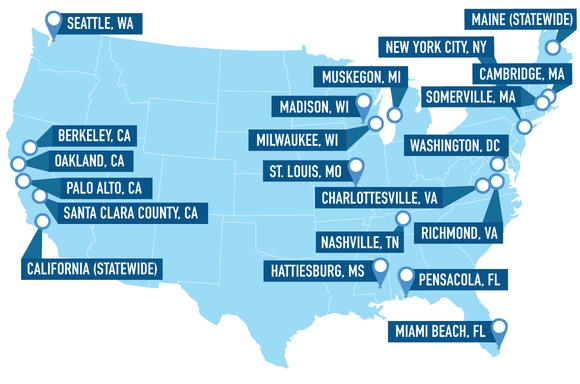Berkeley Mayor: We Passed The “Strongest” Police Surveillance Law
After over a decade of police departments acquiring even more powerful methods for gazing into private lives, and amid ongoing concerns about bias in policing, the city council of Berkeley, California, is attempting to aggressively curb police surveillance by law. On March 27, it unanimously passed an ordinance that broadly covers the city’s acquisition and use of surveillance technologies.
“Say the police or fire department wants to acquire a drone, then they’re going to have to go to the City Council under this policy and get approval for this technology, and include as well a policy governing how the police or fire department can use drones,” Mayor Jesse Arreguin told Fast Company by phone. The law goes into effect on April 29.
Berkeley, where the city council passed a landmark moratorium on drones in 2014, was inspired in part by an ordinance passed in 2016 by Santa Clara County, in the heart of Silicon Valley. In 2016, after a group of residents there banded together against police plans to buy a cell-phone tracking Stingray device, the city council created a transparent review process for the county’s surveillance technology as part of what is considered to be the first such policy in the country.
But Arreguin calls Berkeley’s ordinance “the strongest policy that is on the books—much stronger than Santa Clara County’s,” and appropriately so, “because we’ve always been at the forefront of fighting for protecting people’s civil rights and civil liberties.”
Since 9/11, the federal government has funneled millions of dollars to local law enforcement for new policing technologies. The new Berkeley law creates a more transparent process for purchasing a fast-growing arsenal of surveillance gear, like facial recognition equipment, Stingray cell site simulators, social media analytics software, license plate readers, and any equipment “intended to collect audio, electronic, visual, location, thermal, olfactory, biometric, or similar information specifically associated with, or capable of being associated with, any individual or group.”
The ordinance also governs the extent to which these technologies can be used, in order to balance citizen safety with concerns about civil liberties. Under the new rules, any City of Berkeley department intent on acquiring designated “surveillance technology” must first send the city council a report summarizing the technology, and how and for what purposes they intend to use it. The department must also develop its own policy governing usage of such devices. This information will be published on the City Council agenda, and any member of the public can testify or offer their input. In addition, the law ensures that existing surveillance technology go to the City Council for approval, and that there be annual reporting on that usage. This process, Arreguin says, will “provide an opportunity for the city to evaluate if the technology is being used in a way that conforms to the policies the city adopted.”
The city has said that it does not have most of the surveillance systems targeted by the ordinance, and that it already submits to a public review and approval process for those that it does. And the Berkeley police department has said it already has protections in place to prohibit the sharing of data that’s collected, for example, through its automatic license plate readers.
“In Berkeley, the chief of police said that information was not being shared with third parties,” says Nash Sheard, the Grassroots Advocacy Organizer at the Electronic Frontier Foundation. “So, these ordinances would allow the public to review the policies and ensure that those things are in place in advance.”
Berkeley’s law may become a template for other cities and states considering surveillance restrictions. Sheard notes that in the wake of Berkeley’s law, the City of Davis, California, just passed its own ordinance, as have Seattle, Nashville, and Somerville, Massachusetts. Similar bills are coming up for votes in Oakland and St. Louis, while a group in Evanston, Illinois, is getting the ball rolling for a local surveillance law. Earlier this month, a California surveillance transparency law (SB 1186) passed through its first policy committee with a 5-1 vote.
Sheard also insists that local surveillance isn’t purely a local issue. He points to the Bay Area island of Alameda, which recently launched a proposal to scan the license plates of every vehicle entering San Francisco from Oakland, and everyone that leaves the city, as having larger repercussions. Alameda entered into a contract for scanners with Vigilant Solutions, which recently partnered with U.S. Immigration and Customs Enforcement (ICE) to provide data on car locations. The city recently tabled the proposal over concerns that the data could be sent to ICE agents. The Oakland Privacy Advisory Commission was also recently able to push back on the adoption of more license plate readers, at a time when concerns about ethnic bias and the use of police technology to target vulnerable groups are at a new high.
“Cities need to be aware enough to have these use policies,” says Sheard. “[They need to] be looking at the contracts they are signing with their third-party providers to make sure that they’re not unintentionally creating an opportunity for unsafe situations and risks to public safety, and are instead protecting the members of their own communities.”
Some Exceptions
If the city’s review process determines that law enforcement has violated the rule, it can then request that the agency cease use of that particular technology. If the city fails to act within 90 days, then there is room for legal action. The mayor’s final proposal removed the possibility of any misdemeanor charges or fines, and there’s a $15,000 cap on the attorney’s fees a plaintiff could seek from the city.
“The fundamental purpose of this policy is transparency,” Arreguin says. “It’s making sure the police aren’t secretly purchasing and using surveillance technology without disclosure, and that we have clear policies to govern the use of that technology.”
The final ordinance came together after the City Council spent three hours earlier this month hearing public comment then carefully tweaking its language to accommodate a range of concerns. But Berkeley’s Police Review Commission began crafting the law in 2016, drawing upon help from The Electronic Frontier Foundation, the Council on Islamic Relations, and Berkeley’s Police Review Commission, as well as the American Civil Liberties Union. The ACLU would also offer a template in the form of its model anti-surveillance tech ordinance, known as CCOPS, or Community Control Over Police Surveillance.
[Below, a video of the Berkeley City Council’s April 6 three-hour public discussion about the ordinance.]
City agencies also raised specific concerns throughout the law-writing process. The fire department had worried the proposal might limit the use of thermal imaging cameras during firefighting, while the police department worried about a possible negative impact “on law enforcement investigations and the apprehension of individuals that commit crimes in Berkeley.” The city has also expressed concerns about the “workload and staffing implications related to the administration of the proposed acquisition, use, reporting, and data tracking requirements,” according to a report by the police and fire chiefs earlier this year, as reported by Berkeleyside.
Some privacy advocates have also criticized certain exceptions in the final ordinance. Now, at least six technologies are excluded from the law, including City-issued cell phones that are used by police officers in conjunction with body cameras, a technology that is regulated under the ordinance. Also excluded are “cybersecurity capabilities, technologies, and systems used by the City of Berkeley’s Department of Information Technology.” Jane Welford, executive secretary for SuperBOLD (Berkeleyans Organizing for Liberty Defense), and Gene Bernardi, with Veterans For Peace East Bay Chapter 162, cited this change in a scathing op-ed. “This essentially removes an entire department’s involvement in surveillance from review by City Council.”
The law also carves out exceptions for emergencies. “In exigent circumstances,” it states, “a city department may temporarily acquire or use a surveillance technology without first going through the steps set forth above.” This means that a Berkeley city manager holds a “good faith belief” that an “emergency involving imminent danger of death or serious physical injury to any person, or imminent danger to significant property damage.”
“It could be a terrorist threat, or some major threat to public safety,” Arreguin explains. “But if they intend to use it beyond that exigent circumstance, then they have to come to the City Council for approval.

It Began With Drones
The ordinance has its roots both in Berkeley’s landmark but now-defunct 2014 moratorium on drones, as well as a privacy movement that began in the nearby city of Oakland. A planned surveillance network known as the Domain Awareness Center (DAC) originally conceived in 2013, and supported by federal anti-terror funding, was initially approved by the City Council in 2013. But when the public learned of the details, the system “drew a lot of opposition from privacy advocates and civil rights groups,” Arreguin says. “Which led to a privacy commission and then ultimately toward the idea of developing a privacy policy.”
Originally approved as a surveillance network for the Port of Oakland, DAC’s Phase II proposal would have extended its reach to include the citywide fusion of public and private cameras and sensors from across the city, and at a cost of $10.9 million. Ultimately, the Oakland City Council voted to restrict DAC to its original Port of Oakland mission, removing the citywide ShotSpotter maps (gunshot detection and location mapping) and city traffic cameras from the hub. Oakland also demanded that any expansion of the program come before the Council.
Sheard says that opposition to the city’s surveillance system started in an Occupy Oakland working group, which evolved into Oakland Privacy, one of the Bay Area’s most active groups lobbying for privacy ordinances. The group helped establish the Oakland Privacy Commission, which advises the city council, and which Sheard credits with helping to greatly diminish DAC’s power and reach.
In addition to surveillance ordinances, a number of lawmakers in East Bay cities are also proposing laws that would prevent companies like Vigilant that gather data about immigrants and racial, ethnic, and religious groups for ICE from also doing business with their cities. A proposal in Berkeley was tabled last month over concerns about how to implement the restrictions on investments, but another version of the ordinance is expected to return for a vote soon, according to the East Bay Express.
There are also other efforts afoot to bring more transparency to Berkeley’s police department. State senator Nancy Skinner (D-Berkeley), for instance, is seeking to change the state law to make police use of force records eligible for disclosure, along with records related to on-the-job sexual assault or dishonesty. At the moment, those statistics are withheld from disclosure on the basis of officer personnel privacy rules, an argument that’s been cited by many police agencies, including the New York Police Department.
Despite the exceptions it carves out, Sheard notes that the language in the Berkeley surveillance ordinance helps govern the larger category of surveillance technology, not just specific types. It also addresses mission creep, the shift of a program’s goals that goes far beyond its original mandate. The ordinance states that there would need to be approval in “using surveillance technology in a way not previously approved.”
“Something that we’re not opposed to is the idea of smart cities, so being able to evaluate traffic patterns and have things move more smoothly,” says Sheard. “Having that technology in itself isn’t problematic, but it can be when policies are not in place to make sure that the technology, tools, and equipment are not then used in ways that were not initially listed within the use policies that are required by these ordinances.”
Fast Company , Read Full Story
(20)



